Investigating the Effect of Human Factors on the Underground Mine Evacuation Process Using Agent-Based Simulation
Abstract
1. Introduction
1.1. Human Evacuation Behavior Modeling
1.2. Current Underground Mine Evacuation Strategies and Technologies
2. Scope and Objectives
- Conducting a comprehensive analysis of human behaviors during mine evacuations, identifying and evaluating key behavioral constraints overlooked by previous studies;
- Developing ABS, as an advanced simulation technique for dynamic and realistic circumstances, to model and optimize the evacuation process;
- Implementing an empirical data-driven method for simulating evacuation scenarios and incorporating real-world data on walking and running speeds under various conditions to provide a robust framework for examining and optimizing underground mine evacuation strategies;
- Evidence-based decision-making for individuals’ safety in underground mines by addressing the human factor in mine evacuations and creating more effective and adaptive evacuation protocols.
3. Materials and Methods
- Chaotic Situation: Miners made decisions at every mine intersection. This scenario featured two cases:
- Case 1: Examining evacuation time while increasing the probability of errors;
- Case 2: Introducing pre-evacuation delays and delays at intersections, with increasing error probability and variable miner speeds to examine the effect of stamina on the evacuation times.
- Smart Evacuation: In the smart evacuation scenario, miners were guided by a smart device that eliminated human error by providing real-time, optimized escape routes. A real-time optimization algorithm continuously directed each miner to the safest, nearest shelter based on their current location, any path blockages, available routes, distance to shelters, and individual stamina levels. This guidance was updated dynamically for each person, addressing changing conditions underground. The optimization model underlying this process was designed to solve the minimum-cost network flow algorithm, ensuring that miners reached safety efficiently and with minimized evacuation time. This scenario also featured two cases:
- Case 1: Introducing pre-evacuation delays;
- Case 2: Operating without pre-evacuation delays.
- Passive Signage: In traditional underground mine evacuation scenarios, miners rely on passive signage to navigate toward safe exits. These signs are typically static indicators—such as arrows, illuminated signs, or color-coded paths—that mark designated escape routes. While passive signage is simple and cost-effective, it lacks the ability to adapt to real-time conditions like changing hazards, blocked pathways, or individual miner locations. Consequently, in emergencies with complex or evolving conditions, traditional signage may lead to delays or confusion as miners must interpret and follow predetermined routes that may no longer be optimal. Despite these limitations, passive signage remains a fundamental component of safety protocols and is often combined with training to ensure miners are familiar with evacuation routes. This scenario included the following:
- Single Case: Keeping pre-evacuation delay constant while varying the delay at intersections and the error percentage.
- All miners had the same role.
- There was no interaction between the miners and the environment.
- Only wayfinding and pre-evacuation behaviors were considered.
- Wayfinding and pre-evacuation behaviors were treated as delays.
- All miners evacuated on foot.
- All miners followed the evacuation plan in the smart evacuation scenario; however, their behavior may vary.
- The evacuation time was defined as the time it took for the last miner to leave the mine.
4. Results and Discussion
4.1. Scenario 1: Chaotic Situation
4.2. Scenario 2: Smart Evacuation
4.3. Scenario 3: Passive Signage
4.4. Comparison of Case 1 to Case 2 in Scenario 1
4.5. Comparison of Scenarios 1, 2, and 3
5. Validation of Results
6. Conclusions
Author Contributions
Funding
Institutional Review Board Statement
Informed Consent Statement
Data Availability Statement
Conflicts of Interest
References
- Rendón Rozo, K.; Arellana, J.; Santander-Mercado, A.; Jubiz-Diaz, M. Modelling building emergency evacuation plans considering the dynamic behaviour of pedestrians using agent-based simulation. Saf. Sci. 2019, 113, 276–284. [Google Scholar] [CrossRef]
- Moniri-Morad, A.; Shishvan, M.S.; Aguilar, M.; Goli, M.; Sattarvand, J. Powered haulage safety, challenges, analysis, and solutions in the mining industry; a comprehensive review. Results Eng. 2023, 21, 101684. [Google Scholar] [CrossRef]
- Simpson, G.; Horberry, T.; Joy, J. Understanding Human Error in Mine Safety; CRC Press: Boca Raton, FL, USA, 2009. [Google Scholar]
- Centers for Disease Control and Prevention. Number and Rate of Occupational Mining Fatalities by Year, 1983–2022; Centers for Disease Control and Prevention: Atlanta, Georgia, 2022.
- Esterhuizen, G.S.; Gürtunca, R.G. Coal mine safety achievements in the USA and the contribution of NIOSH research. J. S. Afr. Inst. Min. Metall. 2006, 106, 813–820. [Google Scholar]
- Chen, D.; Wang, L.; Zomaya, A.Y.; Dou, M.; Chen, J.; Deng, Z.; Hariri, S. Parallel simulation of complex evacuation scenarios with adaptive agent models. IEEE Trans. Parallel Distrib. Syst. 2015, 26, 847–857. [Google Scholar] [CrossRef]
- Sumari, S.; Ibrahim, R.; Zakaria, N.H.; Hamijah, A.; Hamid, A. Comparing Three Simulation Model Using Taxonomy: System Dynamic Simulation, Discrete Event Simulation and Agent Based Simulation. Int. J. Manag. Excell. 2013, 1, 54–59. [Google Scholar] [CrossRef]
- Macal, C.M.; North, M.J. Agent-based modeling and simulation. In Proceedings of the Winter Simulation Conference, Austin, TX, USA, 13–16 December 2009; pp. 86–98. [Google Scholar]
- Boateng, M.K.; Awuah-Offei, K. Agent-based modeling framework for modeling the effect of information diffusion on community acceptance of mining. Technol. Forecast. Soc. Chang. 2017, 117, 1–11. [Google Scholar] [CrossRef]
- Zhang, B.; Chan, W.K.; Ukkusuri, S.V. Agent-based discrete-event hybrid space modeling approach for transportation evacuation simulation. In Proceedings of the Winter Simulation Conference, Phoenix, AZ, USA, 11–14 December 2011; pp. 199–209. [Google Scholar]
- Filippoupolitis, A.; Gelenbe, E.; Gianni, D.; Hey, L.; Loukas, G.; Timotheou, S. Distributed agent-based Building Evacuation Simulator. In Proceedings of the Summer Computer Simulation Conference 2008, SCSC 2008, Part of the 2008 Summer Simulation Multiconference, SummerSim 2008, Edinburgh, Scotland, 16–19 June 2008; pp. 46–53. [Google Scholar]
- Yu, Z.; Wang, J.; Luo, W.; Hu, Y.; Yuan, L.; Lü, G. A dynamic evacuation simulation framework based on geometric algebra. Comput. Environ. Urban. Syst. 2016, 59, 208–219. [Google Scholar] [CrossRef]
- Zarboutis, N.; Marmaras, N. Design of formative evacuation plans using agent-based simulation. Saf. Sci. 2007, 45, 920–940. [Google Scholar] [CrossRef]
- Sun, Q.; Turkan, Y. A BIM-based simulation framework for fire safety management and investigation of the critical factors affecting human evacuation performance. Adv. Eng. Inform. 2020, 44, 101093. [Google Scholar] [CrossRef]
- Yin, W.; Murray-Tuite, P.; Ukkusuri, S.V.; Gladwin, H. An agent-based modeling system for travel demand simulation for hurricane evacuation. Transp. Res. Part C Emerg. Technol. 2014, 42, 44–59. [Google Scholar] [CrossRef]
- Lin, J.; Zhu, R.; Li, N.; Becerik-Gerber, B. How occupants respond to building emergencies: A systematic review of behavioral characteristics and behavioral theories. Saf. Sci. 2020, 122, 104540. [Google Scholar] [CrossRef]
- Sime, J.D. Affiliative behaviour during escape to building exits. J. Environ. Psychol. 1983, 3, 21–41. [Google Scholar] [CrossRef]
- Quarantelli, E.L. The nature and conditions of panic. Am. J. Sociol. 1954, 60, 267–275. [Google Scholar] [CrossRef]
- Drury, J.; Novelli, D.; Stott, C. Psychological disaster myths in the perception and management of mass emergencies. J. Appl. Soc. Psychol. 2013, 43, 2259–2270. [Google Scholar] [CrossRef]
- Fischer, H. Response to disaster: Fact versus fiction & its perpetuation: The sociology of disaster. Soc. Forces 1998, 74, 370. [Google Scholar]
- Zhao, C.M.; Lo, S.M.; Zhang, S.P.; Liu, M. A post-fire survey on the pre-evacuation human behavior. Fire Technol. 2009, 45, 71–95. [Google Scholar] [CrossRef]
- Thompson, R.R.; Garfin, D.R.; Silver, R.C. Evacuation from natural disasters: A systematic review of the literature. Risk Anal. 2017, 37, 812–839. [Google Scholar] [CrossRef]
- Kobes, M.; Helsloot, I.; de Vries, B.; Post, J.G.; Oberijé, N.; Groenewegen, K. Way finding during fire evacuation; an analysis of unannounced fire drills in a hotel at night. Build. Environ. 2010, 45, 537–548. [Google Scholar] [CrossRef]
- Haghani, M.; Sarvi, M. How perception of peer behaviour influences escape decision making: The role of individual differences. J. Environ. Psychol. 2017, 51, 141–157. [Google Scholar] [CrossRef]
- Bi, H.; Shang, W.L.; Chen, Y.; Wang, K. Joint Optimization for Pedestrian, Information and Energy Flows in Emergency Response Systems With Energy Harvesting and Energy Sharing. IEEE Trans. Intell. Transp. Syst. 2022, 23, 22421–22435. [Google Scholar] [CrossRef]
- Kugihara, N. Effects of aggressive behaviour and group size on collective escape in an emergency: A test between a social identity model and deindividuation theory. Br. J. Soc. Psychol. 2001, 40, 575–598. [Google Scholar] [CrossRef] [PubMed]
- Nicolas, A.; Bouzat, S.; Kuperman, M.N. Pedestrian flows through a narrow doorway: Effect of individual behaviours on the global flow and microscopic dynamics. Transp. Res. Part B Methodol. 2017, 99, 30–43. [Google Scholar] [CrossRef]
- Cuesta, A.; Abreu, O.; Balboa, A.; Alvear, D. Alone or with others: Experiments on evacuation decision making. Fire Saf. J. 2021, 120, 103018. [Google Scholar] [CrossRef]
- Drury, J. The role of social identity processes in mass emergency behaviour: An integrative review. Eur. Rev. Soc. Psychol. 2018, 29, 38–81. [Google Scholar] [CrossRef]
- Shields, T.J.; Boyce, K.E.; McConnell, N. The behaviour and evacuation experiences of WTC 9/11 evacuees with self-designated mobility impairments. Fire Saf. J. 2009, 44, 881–893. [Google Scholar] [CrossRef]
- Vorst, H.C.M. Evacuation models and disaster psychology. Procedia Eng. 2010, 3, 15–21. [Google Scholar] [CrossRef]
- Fu, M.; Liu, R.; Zhang, Y. Do people follow neighbors? An immersive virtual reality experimental study of social influence on individual risky decisions during evacuations. Autom. Constr. 2021, 126, 103644. [Google Scholar] [CrossRef]
- Fridolf, K.; Nilsson, D.; Frantzich, H. Fire Evacuation in Underground Transportation Systems: A Review of Accidents and Empirical Research. Fire Technol. 2013, 49, 451–475. [Google Scholar] [CrossRef]
- McLennan, J.; Ryan, B.; Bearman, C.; Toh, K. Should We Leave Now? Behavioral Factors in Evacuation Under Wildfire Threat. Fire Technol. 2019, 55, 487–516. [Google Scholar] [CrossRef]
- Conti, R.; Chasko, L.; Wiehagen, W.; Lazzara, C. Fire Response Preparedness for Underground Mines; Department of Health and Human Services, Centers for Disease Control and Prevention, National Institute for Occupational Safety and Health: Atlanta, Georgia, 2005.
- Pomroy, W.H.; Muldoon, T.L. Improved Stench Fire Warning for Underground Mines; Information Circular—United States, Bureau of Mines: Washington, DC, USA, 1985.
- Battulwar, R.; Emami, E.; Zare, M.; Battulwar, K.; Shahsavar, M.; Moniri-Morad, A.; Sattarvand, J. Utilizing Deep Learning for the Automated Extraction of Rock Mass Features from Point Clouds. Geotech. Geol. Eng. 2024, 42, 6179–6194. [Google Scholar] [CrossRef]
- Ur Rehman, A.; Lyche, T.; Awuah-Offei, K.; Nadendla, V.S.S. Effect of text message alerts on miners evacuation decisions. Saf. Sci. 2020, 130, 104875. [Google Scholar] [CrossRef]
- Molaei, F.; Rahimi, E.; Siavoshi, H.; Afrouz, S.G.; Tenorio, V. A Comprehensive Review on Internet of Things (IoT) and its Implications in the Mining Industry. Am. J. Eng. Appl. Sci. 2020, 13, 499–515. [Google Scholar] [CrossRef]
- Radinovic, G.; Kim, K. Feasibility Studyof RFID/Wi-Fi/BlueTooth Wireless Tracking System for Underground Mine Mapping—Oklaohoma. In Proceedings of the “Incorporating Geospatial Technologies into SMCRA BusinessProcesses”, Atlanta, GA, USA, 25–27 March 2008; pp. 1–34. [Google Scholar]
- Meij, R.; Shishvan, M.S.; Sattarvand, J. The Development of a New Smart Evacuation Modeling Technique for Underground Mines Using Mathematical Programming. Mining 2024, 4, 106–119. [Google Scholar] [CrossRef]
- Rehman, A.U.; Awuah-Offei, K.; Baker, D.A.; Bristow, D. Emergency evacuation guidance system for underground miners. In Proceedings of the SME Annual Meeting 2019, Denver, CO, USA, 24–27 February 2019; pp. 19–100. [Google Scholar]
- Ali, M.; El-Aziz, A.A.; Elwageeh, M. Optimization of escape routes during mine fire using GIS. Min. Technol. 2023, 132, 55–64. [Google Scholar] [CrossRef]
- Asare, F.K.; Moniri-Morad, A.; Augustine, P.C.; Sattarvand, J. Vehicle-Augmented Evacuation Integer Programming Model for Improving Safety and Efficiency in Underground Mines. J. Saf. Sci. Resil. 2024; in press. [Google Scholar]
- Jalali, S.E.; Noroozi, M. Determination of the optimal escape routes of underground mine networks in emergency cases. Saf. Sci. 2009, 47, 1077–1082. [Google Scholar] [CrossRef]
- Marsh, E.; Dahl, J.; Kamran Pishhesari, A.; Sattarvand, J.; Harris, F.C. A Virtual Reality Mining Training Simulator for Proximity Detection. In Proceedings of the ITNG 2023 20th International Conference on Information Technology-New Generations, Las Vegas, NV, USA, 24–26 April 2023; pp. 387–393. [Google Scholar]
- Kamran-Pishhesari, A.; Moniri-Morad, A.; Sattarvand, J. Applications of 3D Reconstruction in Virtual Reality-Based Teleoperation: A Review in the Mining Industry. Technologies 2024, 12, 40. [Google Scholar] [CrossRef]
- Zhang, H. Head-mounted display-based intuitive virtual reality training system for the mining industry. Int. J. Min. Sci. Technol. 2017, 27, 717–722. [Google Scholar] [CrossRef]
- Mitra, R.; Hebblewhite, B.; Saydam, S. Improving Mine Safety and Mining Education through use of virtual reality. In Proceedings of the 36th International Conference of Safety in Mines Research Institutes, Sudbury, ON, Canada, 25–27 October 2015. [Google Scholar]
- Tichon, J.; Burgess-Limerick, R. A review of Virtual Reality as a medium for safety related training in Mining. J. Health Saf. Res. Pract. 2011, 3, 33–40. [Google Scholar]
- Van Wyk, E.; De Villiers, R. Virtual reality training applications for the mining industry. In Proceedings of the AFRIGRAPH 2009: 6th International Conference on Computer Graphics, Virtual Reality, Visualisation and Interaction in Africa, Pretoria, South Africa, 4–6 February 2009; Association for Computing Machinery: New York, NY, USA, 2009; Volume 1, pp. 53–64. [Google Scholar]
- Kizil, M. Virtual reality applications in the Australian minerals industry. In Proceedings of the APCOM 2003—31st International Symposium on Application of Computers and Operations Research in the Minerals Industries, Cape Town, South Africa, 14–16 May 2003; pp. 569–574. [Google Scholar]
- Kizil, M.; Kerridge, A.; Hancock, M. Use of virtual reality in mining education and training. In Proceedings of the CRCMining Conference, Noosa Head, QLD, Australia, 15–16 June 2004. [Google Scholar]
- Liu, Z.; Jacques, C.C.; Szyniszewski, S.; Guest, J.K.; Schafer, B.W.; Igusa, T.; Mitrani-Reiser, J. Agent-Based Simulation of Building Evacuation after an Earthquake: Coupling Human Behavior with Structural Response. Nat. Hazards Rev. 2016, 17, 04015019. [Google Scholar] [CrossRef]
- AnyLogic Help. Library Reference Guides; AnyLogic Help: Oakbrook Terrace, IL, USA, 2024. [Google Scholar]
- Poulos, A.; Tocornal, F.; de la Llera, J.C.; Mitrani-Reiser, J. Validation of an agent-based building evacuation model with a school drill. Transp. Res. Part C Emerg. Technol. 2018, 97, 82–95. [Google Scholar] [CrossRef]

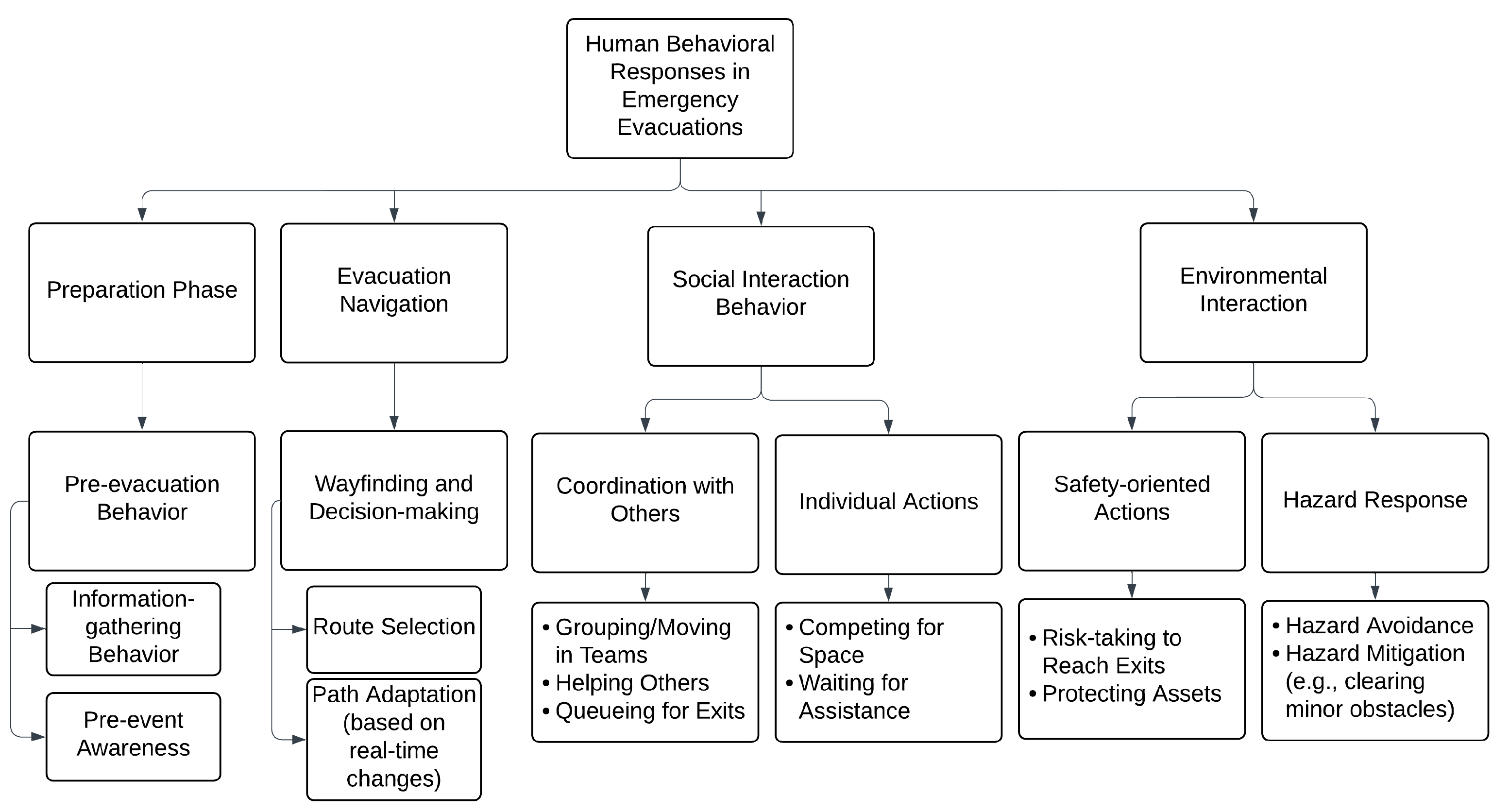
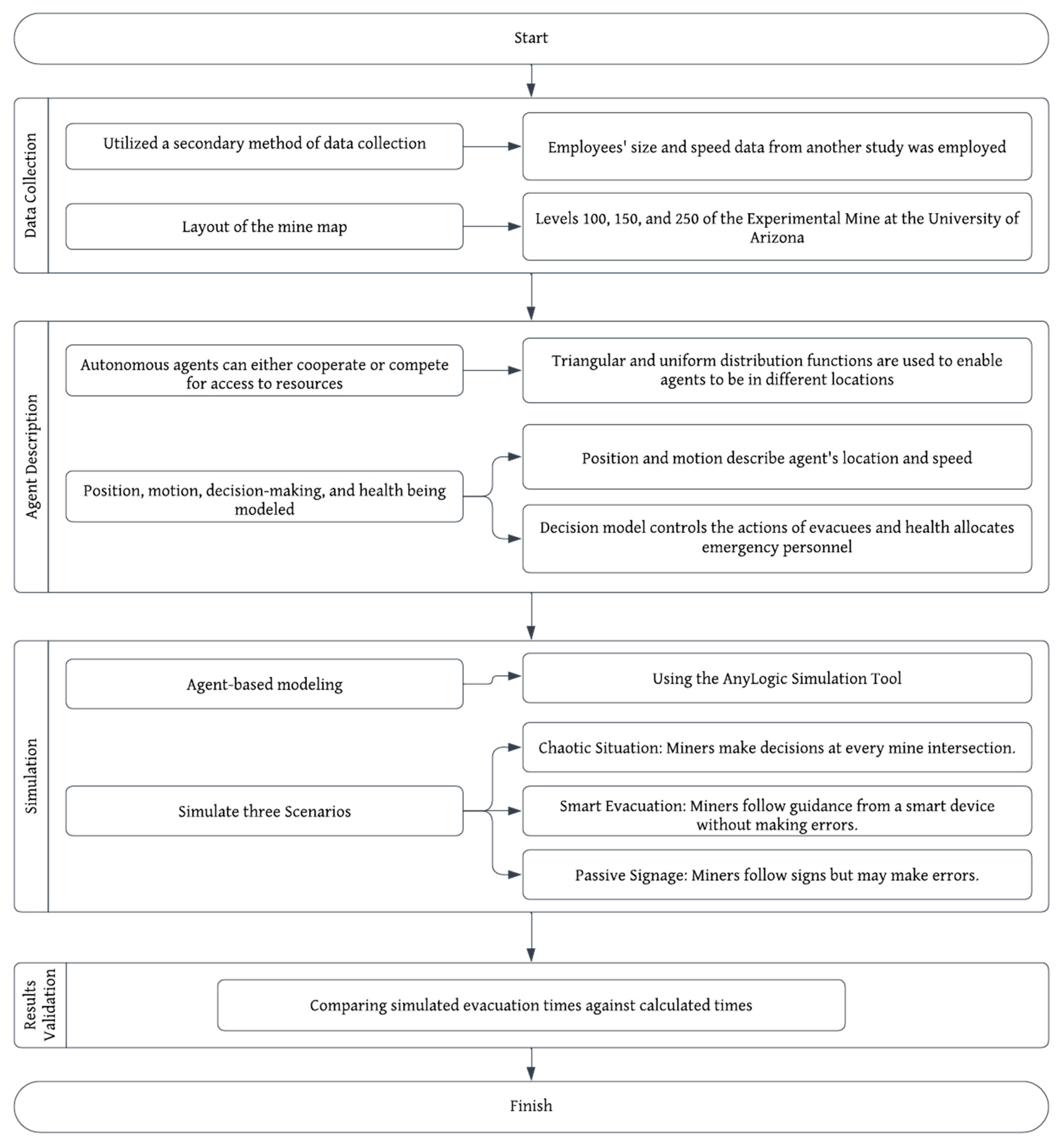
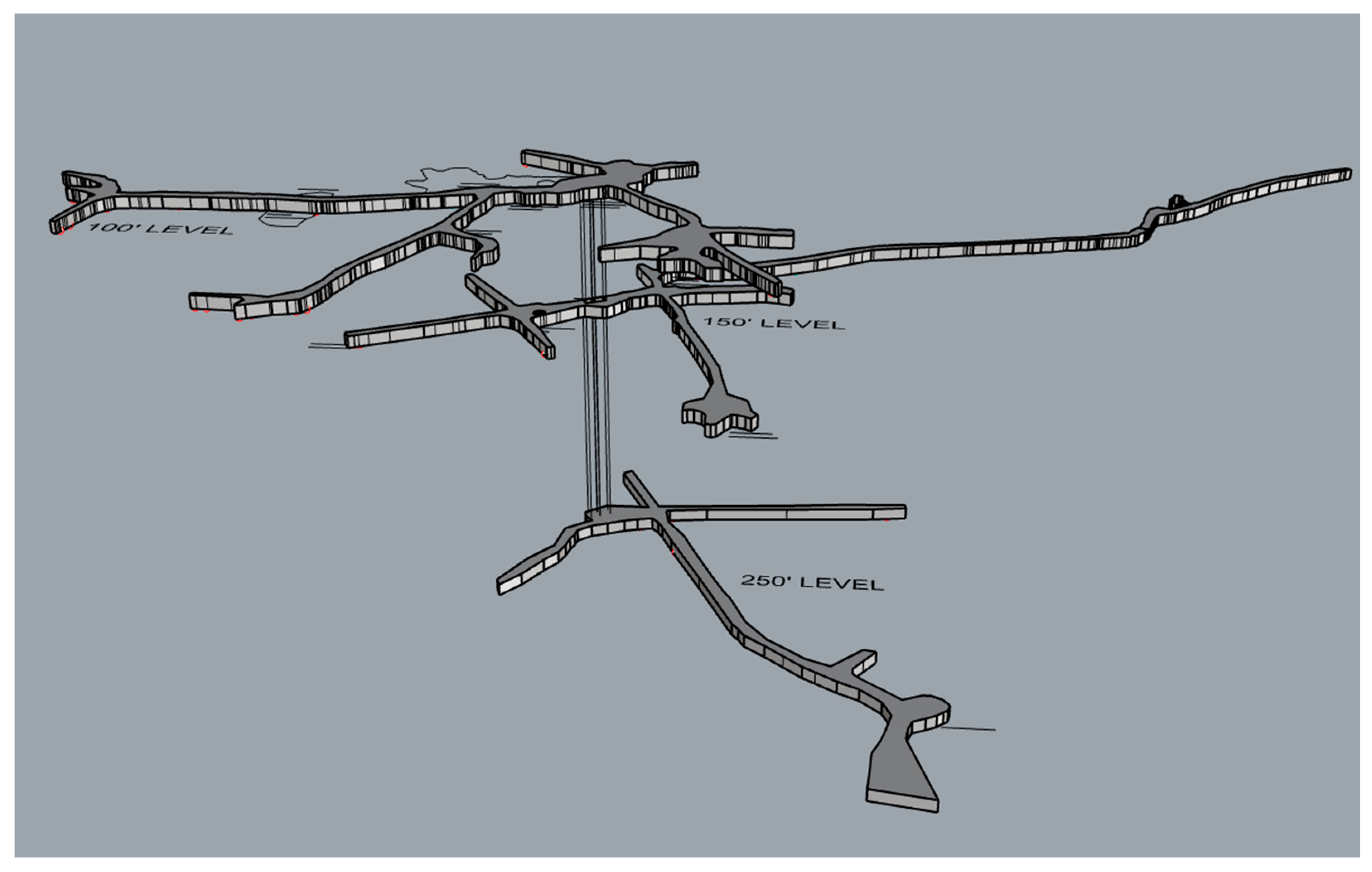


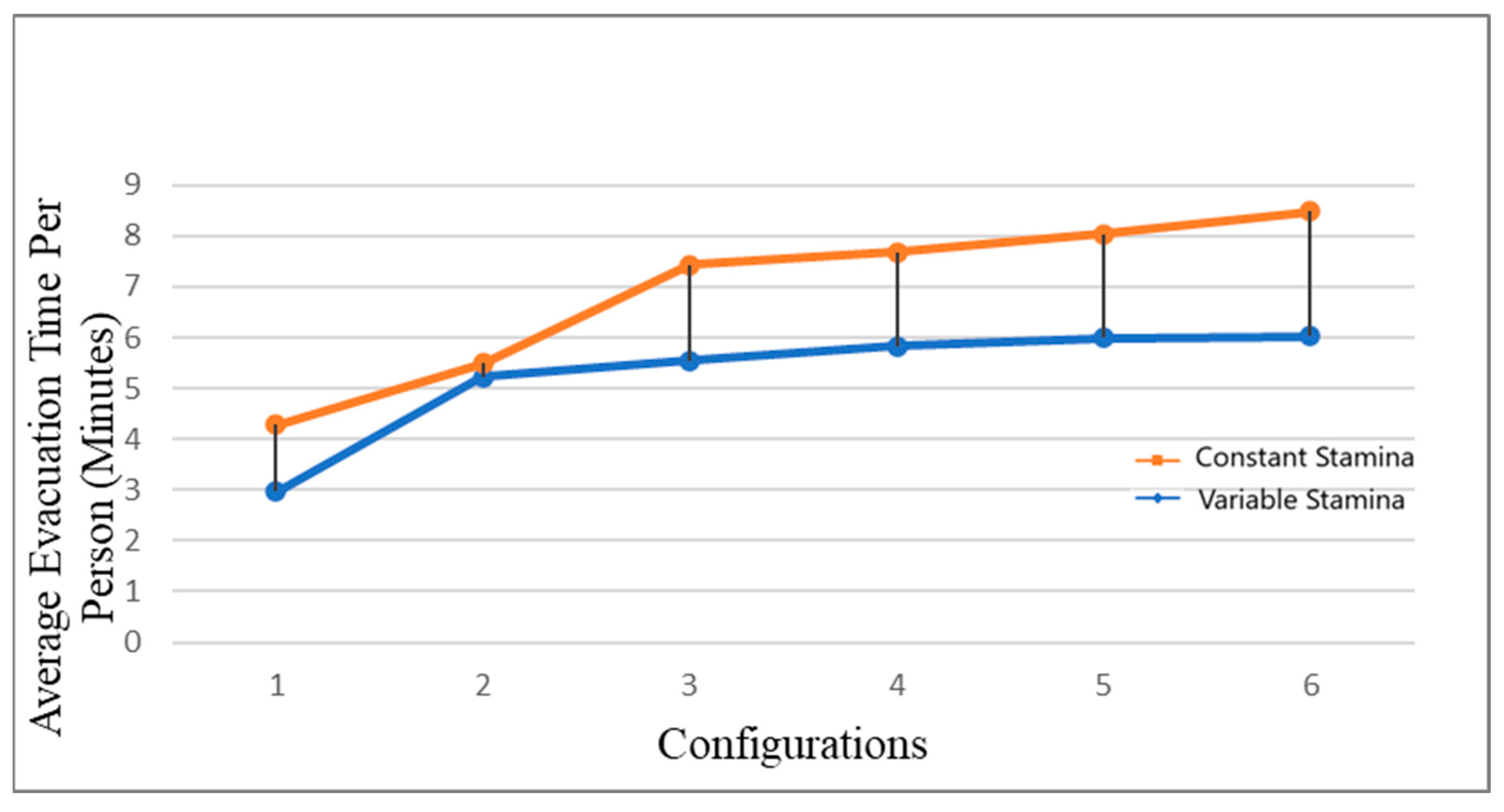
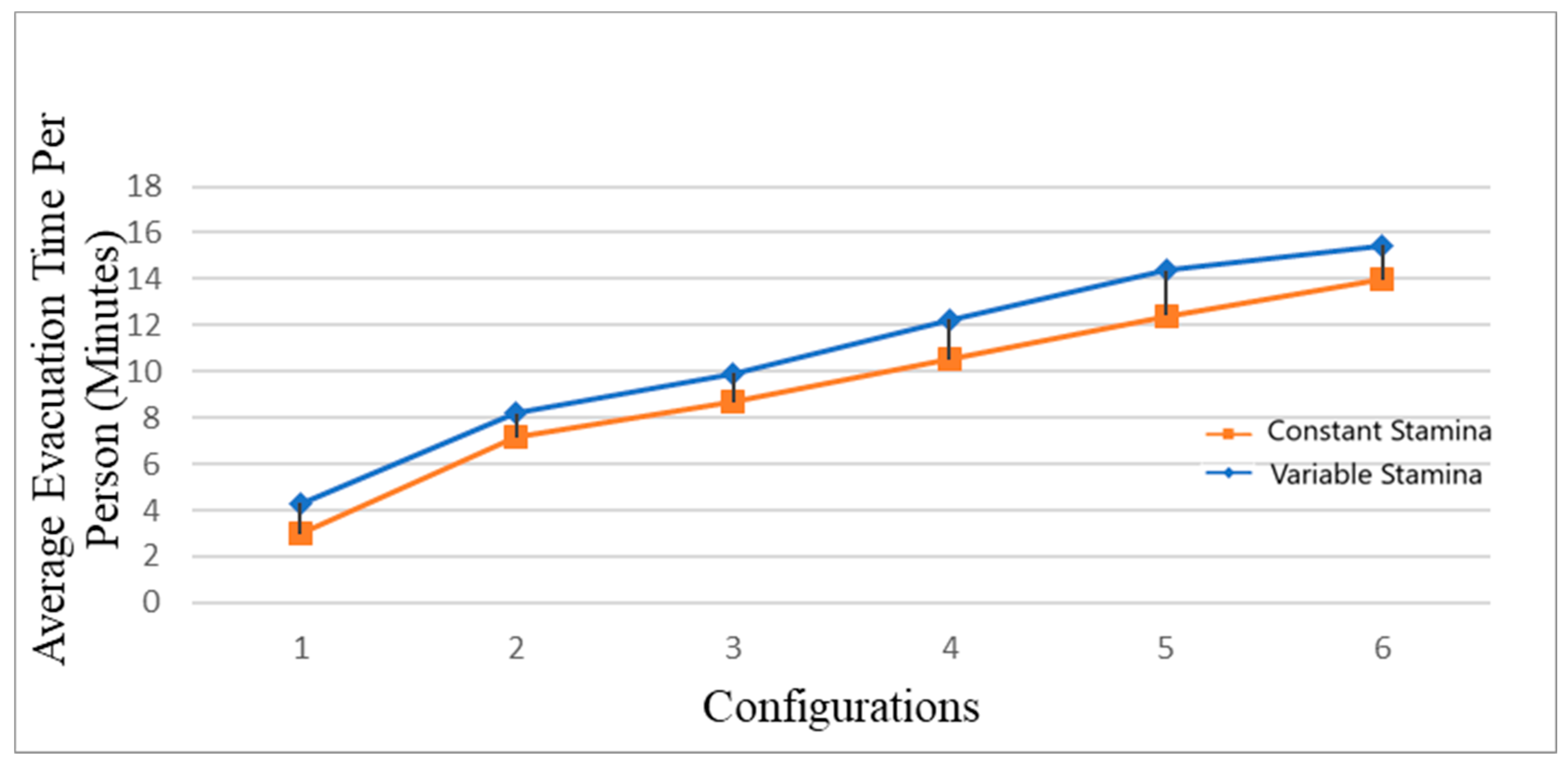
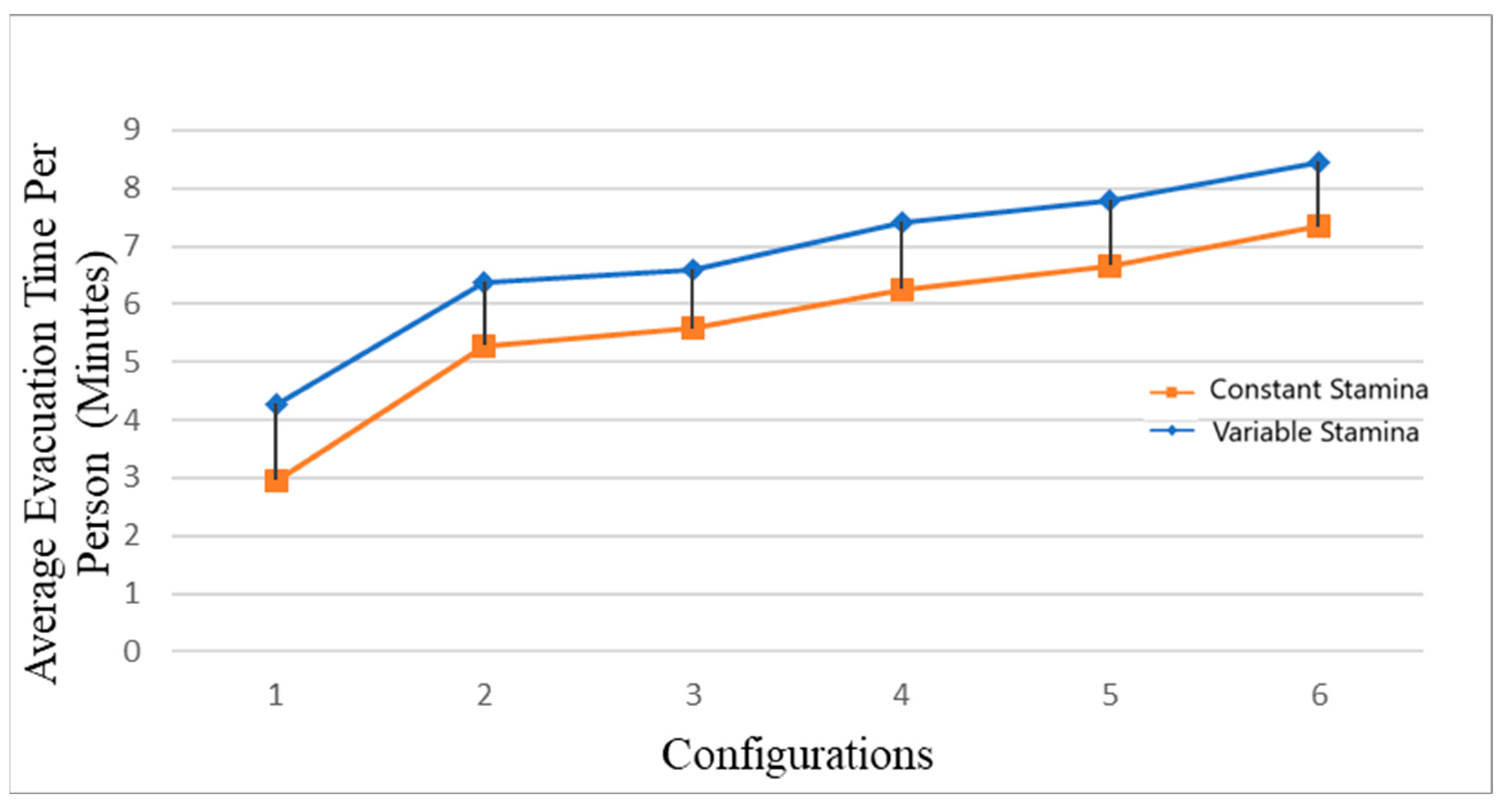
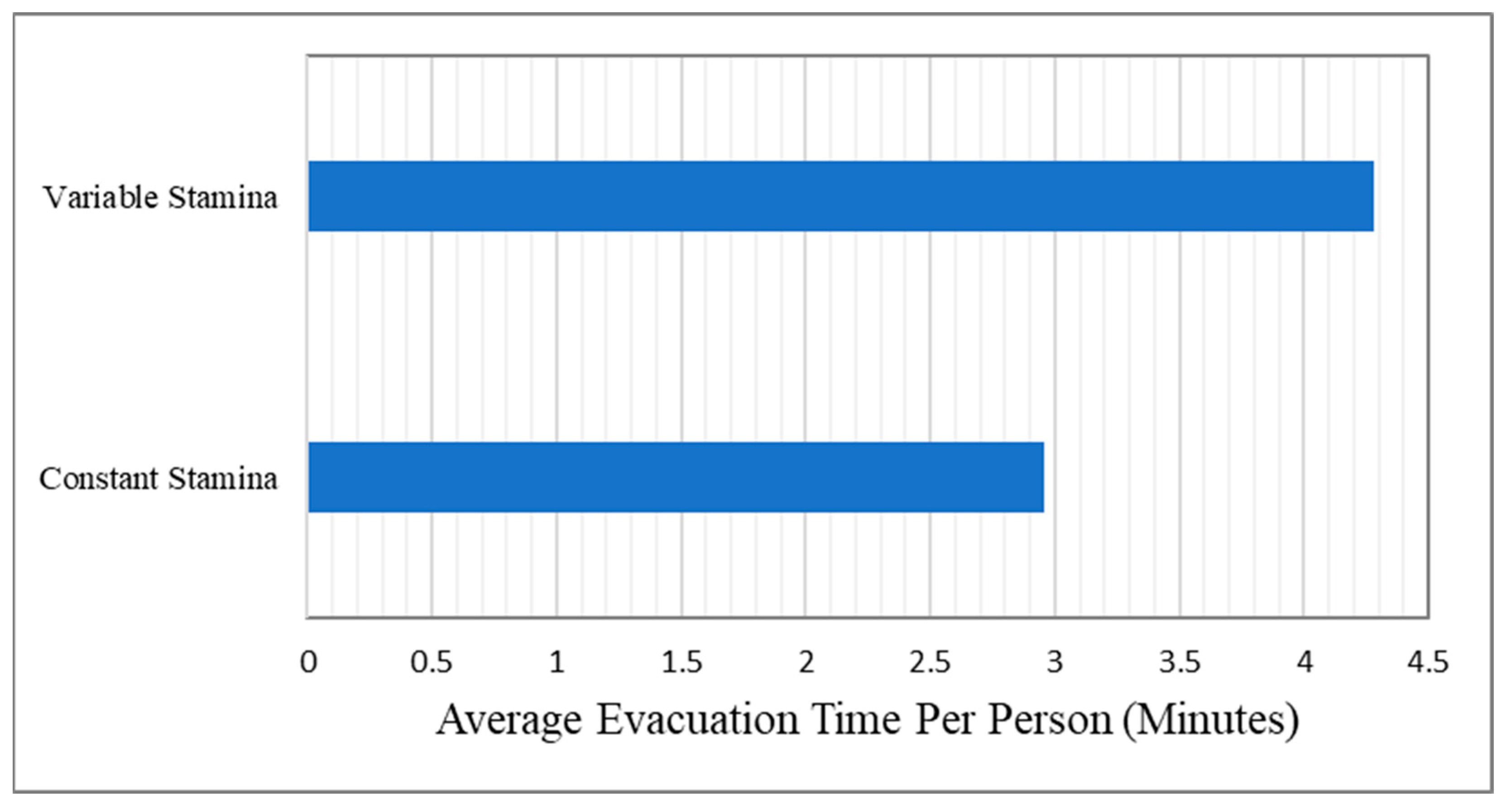
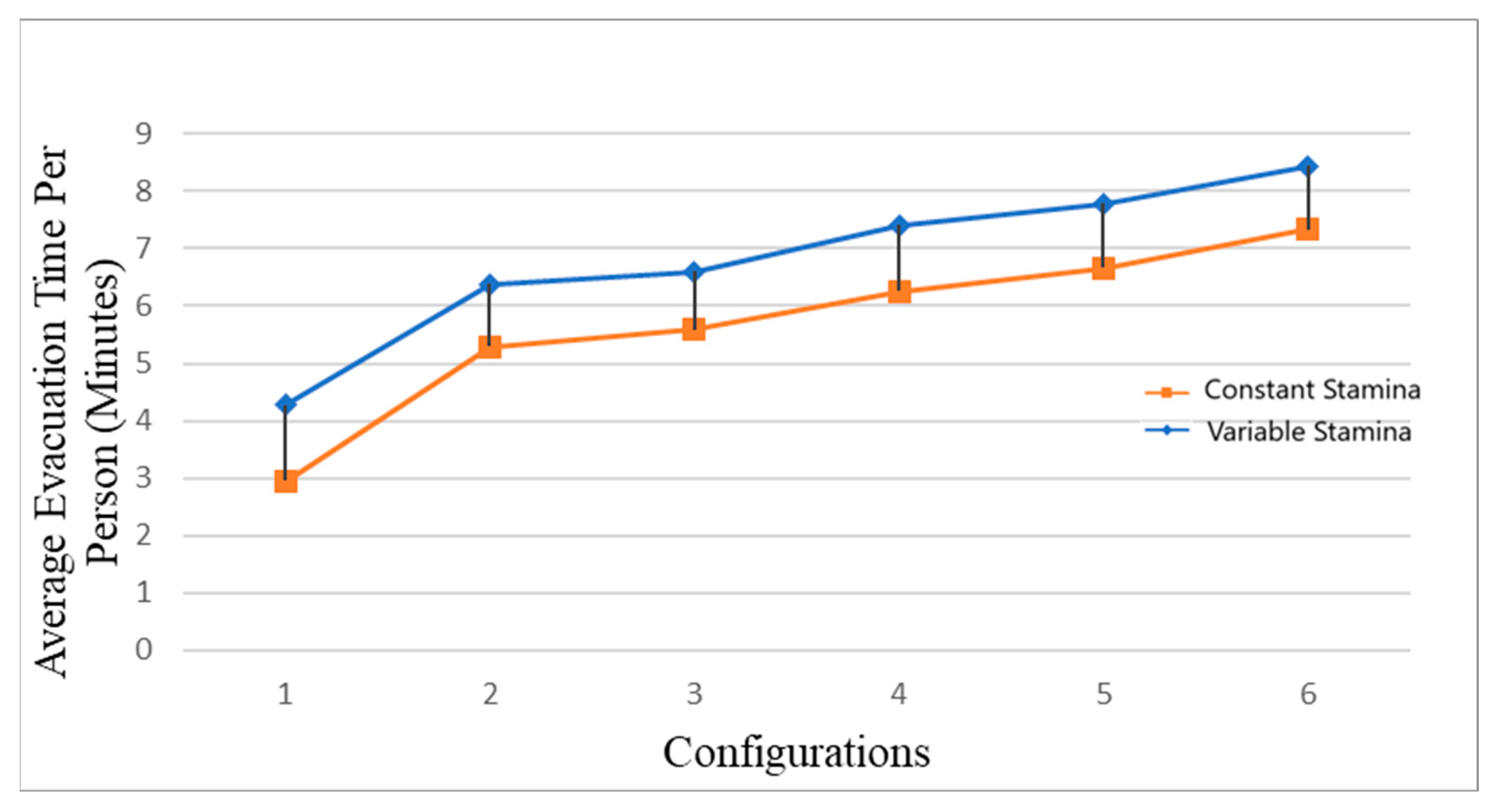
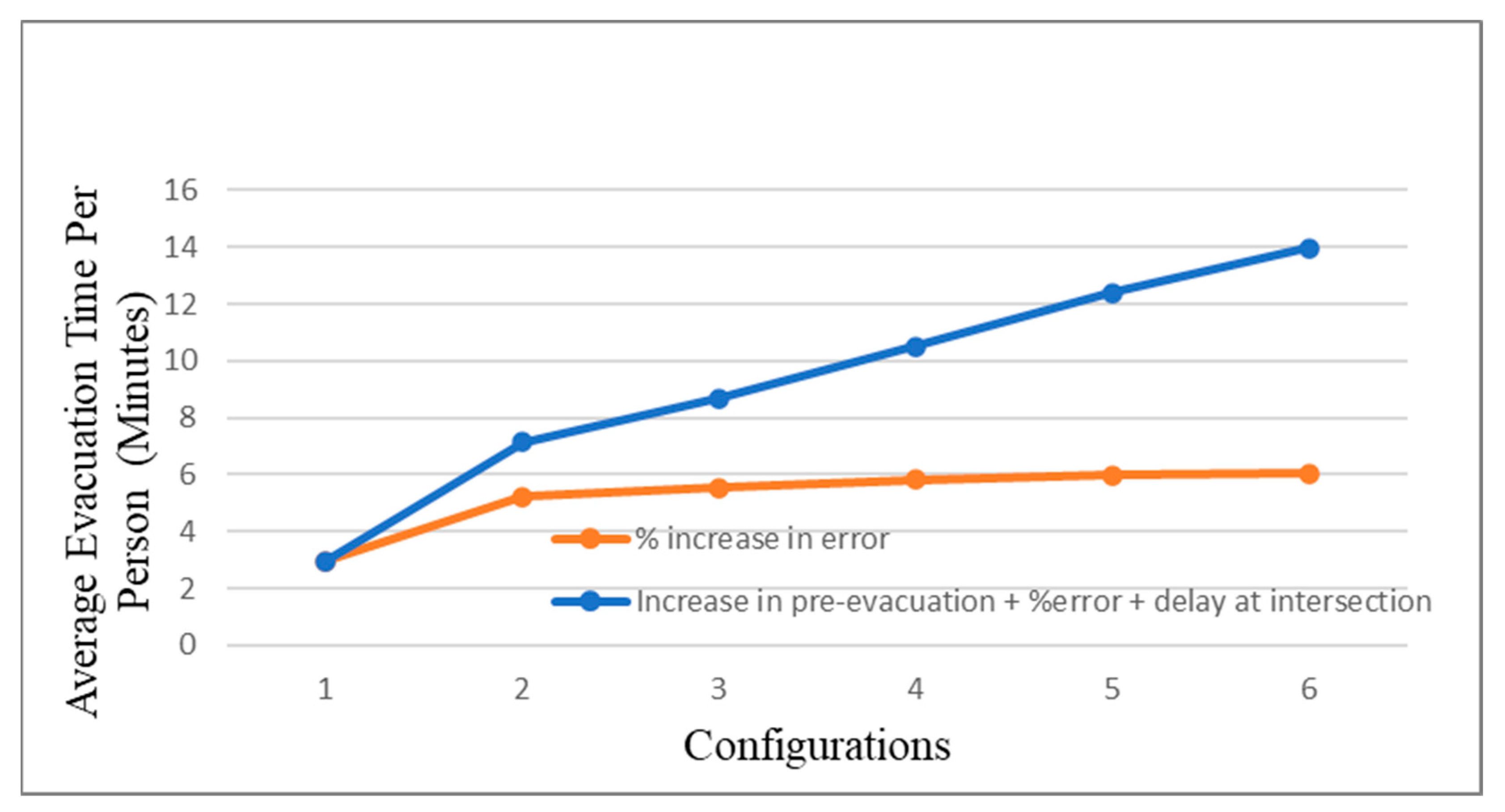
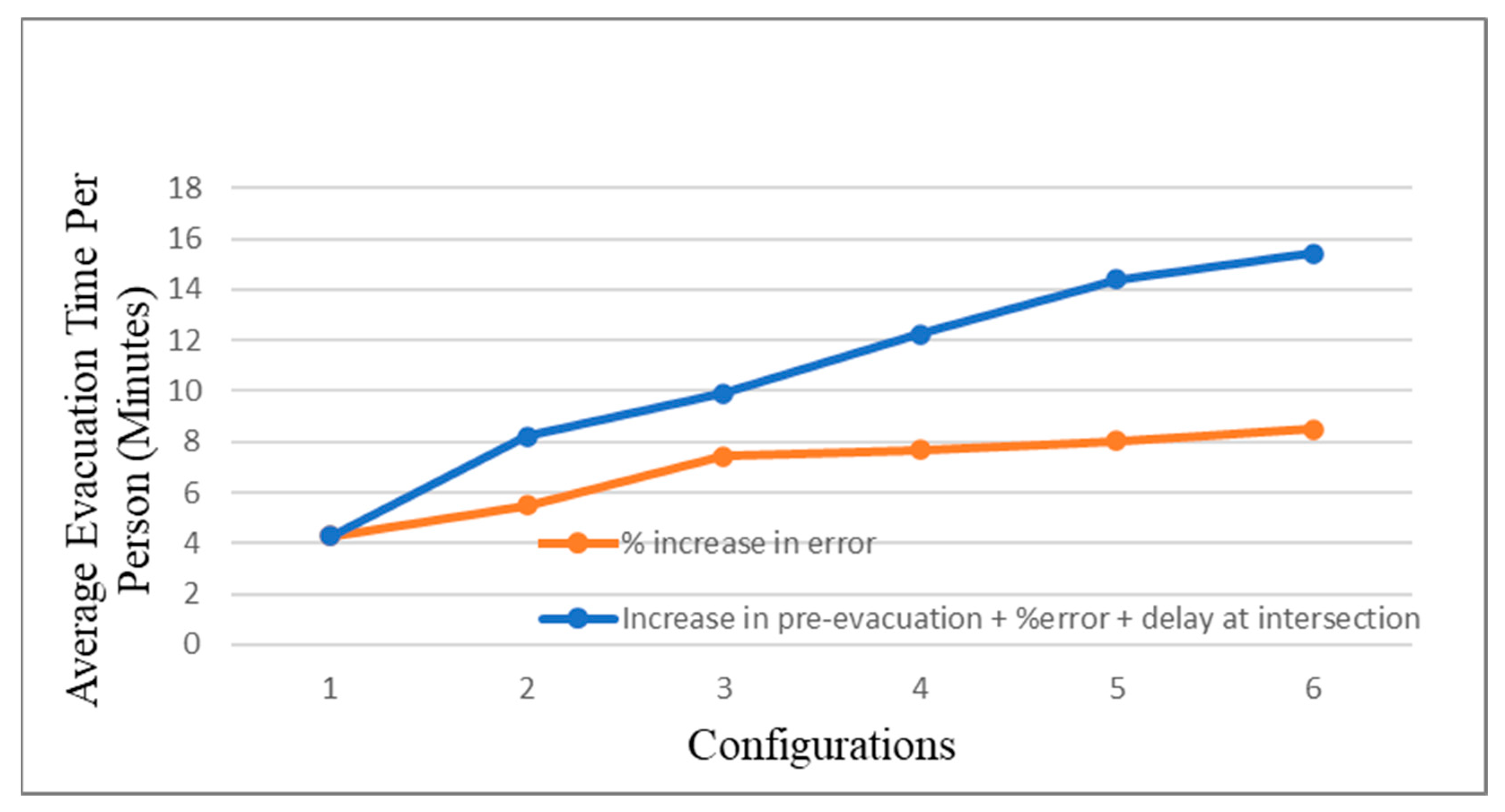

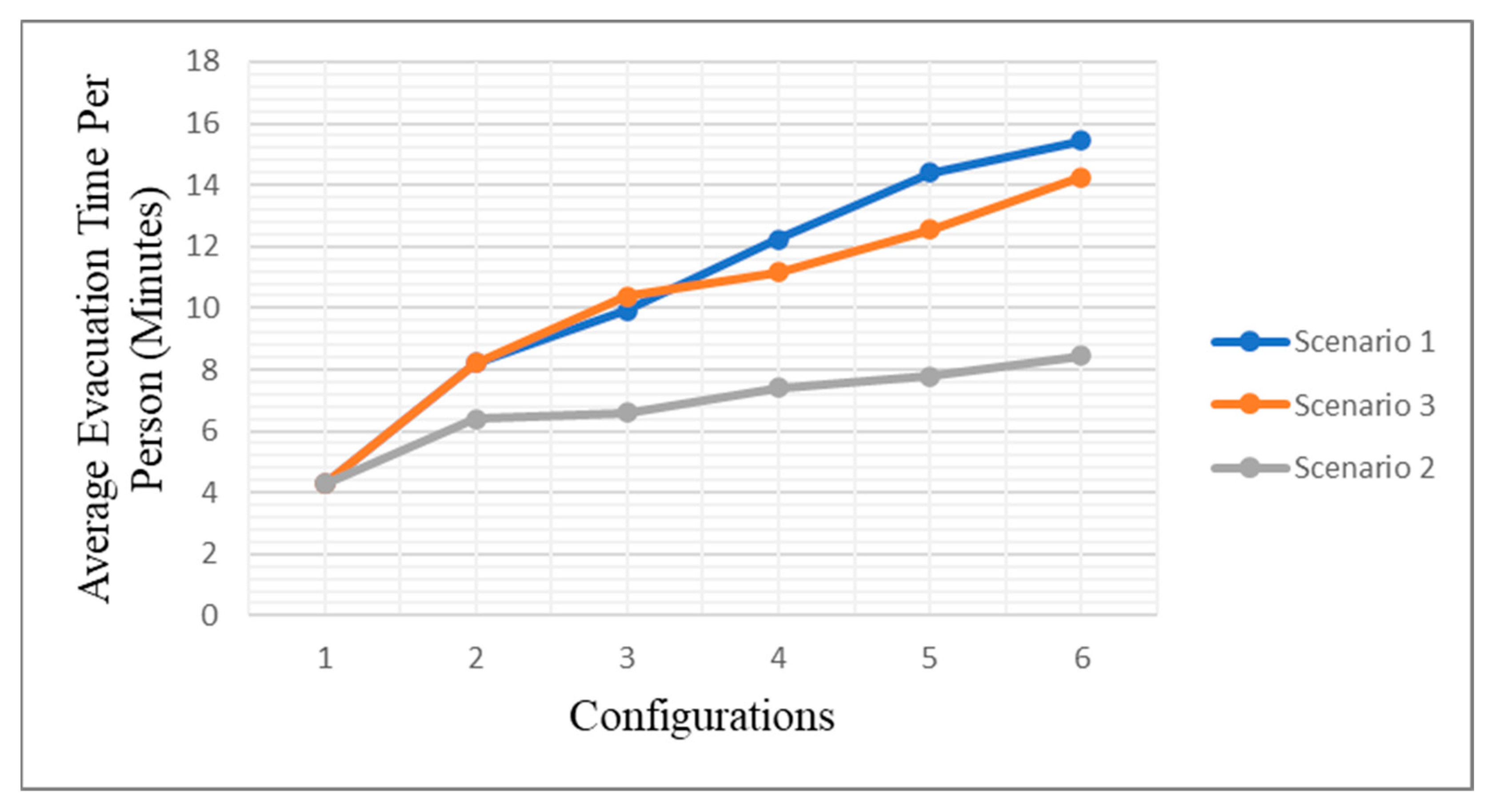
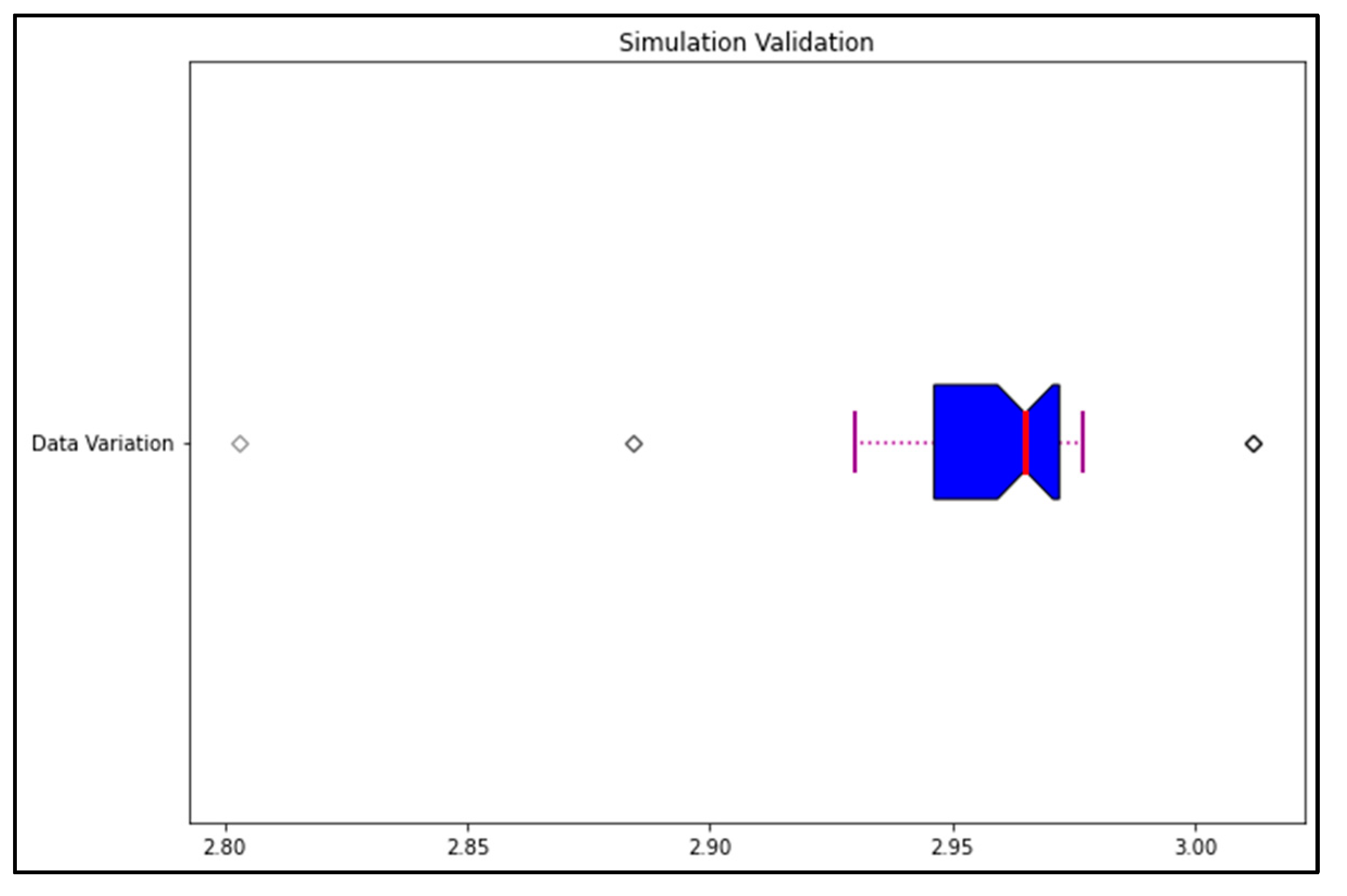
| Simulation Data | Configuration 1 | Configuration 2 | Configuration 3 | Configuration 4 | Configuration 5 | Configuration 6 |
|---|---|---|---|---|---|---|
| Pre-evacuation delay (minutes) | 0 | 0 | 0 | 0 | 0 | 0 |
| Delay at intersection (minutes) | 0 | 0 | 0 | 0 | 0 | 0 |
| Probability of error (%) | 0 | 20 | 40 | 60 | 80 | 100 |
| Speed (constant value) (m/s) | 1.48 | 1.48 | 1.48 | 1.48 | 1.48 | 1.48 |
| Speed (m/s) (Uniform distribution) | (0.9, 1.48) | (0.9, 1.49) | (0.9, 1.50) | (0.9, 1.51) | (0.9, 1.52) | (0.9, 1.48) |
| Simulation Data | Configuration 1 | Configuration 2 | Configuration 3 | Configuration 4 | Configuration 5 | Configuration 6 |
|---|---|---|---|---|---|---|
| Pre-evacuation delay (minutes) (triangular distribution) | (0, 0, 0) | (0, 1, 1) | (0, 1, 2) | (0, 1, 3) | (0, 1, 4) | (0, 1, 5) |
| Delay at intersection (minutes) (triangular distribution) | (0, 0, 0) | (0, 1, 1) | (0, 1, 2) | (0, 1, 3) | (0, 1, 4) | (0, 1, 5) |
| Probability of error (%) | 0 | 20 | 40 | 60 | 80 | 100 |
| Speed (constant value) (m/s) | 1.48 | 1.48 | 1.48 | 1.48 | 1.48 | 1.48 |
| Speed (m/s) (uniform distribution) | (0.9, 1.48) | (0.9, 1.49) | (0.9, 1.50) | (0.9, 1.51) | (0.9, 1.52) | (0.9, 1.48) |
| Simulation Data | Configuration 1 | Configuration 2 | Configuration 3 | Configuration 4 | Configuration 5 | Configuration 6 |
|---|---|---|---|---|---|---|
| Pre-evacuation delay (minutes) (triangular distribution) | (0, 0, 0) | (0, 1, 1) | (0, 1, 2) | (0, 1, 3) | (0, 1, 4) | (0, 1, 5) |
| Delay at intersection (minutes) (triangular distribution) | (0, 0, 0) | (0, 1, 1) | (0, 1, 1) | (0, 1, 1) | (0, 1, 1) | (0, 1, 1) |
| Probability of error (%) | 0 | 0 | 0 | 0 | 0 | 0 |
| Speed (m/s) (constant value) | 1.48 | 1.48 | 1.48 | 1.48 | 1.48 | 1.48 |
| Speed (m/s) (uniform distribution) | (0.9, 1.48) | (0.9, 1.49) | (0.9, 1.50) | (0.9, 1.51) | (0.9, 1.52) | (0.9, 1.48) |
| Simulation Data | Constant Stamina | Variable Stamina |
|---|---|---|
| Pre-evacuation delay (minutes) | 0 | 0 |
| Delay at intersection (minutes) | 0 | 0 |
| Probability of error (%) | 0 | 0 |
| Speed (m/s) | Constant | Variable |
| Simulation Data | Configuration 1 | Configuration 2 | Configuration 3 | Configuration 4 | Configuration 5 | Configuration 6 |
|---|---|---|---|---|---|---|
| Pre-evacuation delay (minutes) (triangular distribution) | (0, 0,0) | (0, 1, 1) | (0, 1, 1) | (0, 1, 1) | (0, 1, 1) | (0, 1, 1) |
| Delay at intersection (minutes) (triangular distribution) | (0, 0, 0) | (0, 1, 1) | (0, 1, 2) | (0, 1, 3) | (0,1,4) | (0, 1, 5) |
| Probability of error (%) | 0 | 20 | 40 | 60 | 80 | 100 |
| Speed (constant value) (m/s) | 1.48 | 1.48 | 1.48 | 1.48 | 1.48 | 1.48 |
| Speed (m/s) (uniform distribution) | (0.9, 1.48) | (0.9, 1.49) | (0.9, 1.50) | (0.9, 1.51) | (0.9, 1.52) | (0.9, 1.48) |
Disclaimer/Publisher’s Note: The statements, opinions and data contained in all publications are solely those of the individual author(s) and contributor(s) and not of MDPI and/or the editor(s). MDPI and/or the editor(s) disclaim responsibility for any injury to people or property resulting from any ideas, methods, instructions or products referred to in the content. |
© 2024 by the authors. Licensee MDPI, Basel, Switzerland. This article is an open access article distributed under the terms and conditions of the Creative Commons Attribution (CC BY) license (https://creativecommons.org/licenses/by/4.0/).
Share and Cite
Augustine, P.C.; Moniri-Morad, A.; Shahsavar, M.; Sattarvand, J. Investigating the Effect of Human Factors on the Underground Mine Evacuation Process Using Agent-Based Simulation. Appl. Sci. 2024, 14, 11773. https://doi.org/10.3390/app142411773
Augustine PC, Moniri-Morad A, Shahsavar M, Sattarvand J. Investigating the Effect of Human Factors on the Underground Mine Evacuation Process Using Agent-Based Simulation. Applied Sciences. 2024; 14(24):11773. https://doi.org/10.3390/app142411773
Chicago/Turabian StyleAugustine, Peter Chidi, Amin Moniri-Morad, Mahdi Shahsavar, and Javad Sattarvand. 2024. "Investigating the Effect of Human Factors on the Underground Mine Evacuation Process Using Agent-Based Simulation" Applied Sciences 14, no. 24: 11773. https://doi.org/10.3390/app142411773
APA StyleAugustine, P. C., Moniri-Morad, A., Shahsavar, M., & Sattarvand, J. (2024). Investigating the Effect of Human Factors on the Underground Mine Evacuation Process Using Agent-Based Simulation. Applied Sciences, 14(24), 11773. https://doi.org/10.3390/app142411773







